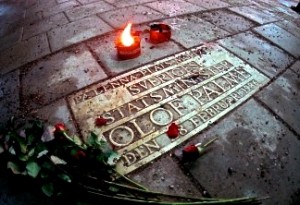Note: Jonas T. Bengtsson has been WINNER of the BG Bank First Book Award and WINNER of the Per Olov Enqvist Literary Prize. This novel was a FINALIST for the Danish Radio Literature Prize for Best Novel of the Year.
“I wish I could drive a car without a number plate, that my feet didn’t leave footprints in the snow. But that’s not possible. So you have to trust people. Not always and not unconditionally. But you have to trust that if they like you, then they’ll do a lot to help you. And that’s worth much more than the money…” – comments by the young boy’s father.
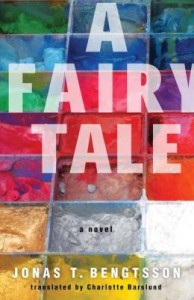 This can’t-put-it-downer of novel about three generations of a disturbed family excites and unnerves the reader at the same time that it puzzles and terrifies with its eerie atmosphere and constant sense of imminent doom. A coming-of-age novel with a twist, it reveals the trials of a young boy, age six when the novel opens, constantly moving with his father through dark locales from Sweden to Denmark, and the reader quickly discerns that the father is hiding a terrible secret from the boy, who is never named, and from everyone else. The boy and his father clearly love and support each other, but they are constantly moving, and their lives are always changing with the father’s succession of oddball, low-paying jobs. The father, whom we come to know well, is obviously educated and intelligent, though he works doing manual labor, and when he has time at night, he tells the child stories about a King and a Prince who no longer have a home.
This can’t-put-it-downer of novel about three generations of a disturbed family excites and unnerves the reader at the same time that it puzzles and terrifies with its eerie atmosphere and constant sense of imminent doom. A coming-of-age novel with a twist, it reveals the trials of a young boy, age six when the novel opens, constantly moving with his father through dark locales from Sweden to Denmark, and the reader quickly discerns that the father is hiding a terrible secret from the boy, who is never named, and from everyone else. The boy and his father clearly love and support each other, but they are constantly moving, and their lives are always changing with the father’s succession of oddball, low-paying jobs. The father, whom we come to know well, is obviously educated and intelligent, though he works doing manual labor, and when he has time at night, he tells the child stories about a King and a Prince who no longer have a home.
This sinister “fairy tale” has little in common with the beloved stories of Hans Christian Andersen. Here, “The King and the Prince have gone out into the world to find the White Queen and kill her. With an arrow or a knife, a single stab through her heart will lift the curse. They’re the only ones who can do it because the King and the Prince are the last people who can see the world as it really is.” White Men work for the wicked Queen, and the boy grows up trying to avoid the White Men always lying in wait for him and his father. How and why the White Queen placed a curse upon them, alienating both from the rest of the world, is unclear, at first, but the symbolic effects of this alienation pervade the entire novel.
Danish author Jonas T. Bengtsson opens this novel in Sweden in 1986, just as Swedish Prime Minister Olov Palme is shot and killed while returning home with his wife from the cinema, which he has attended without bodyguards. The boy’s father, sobbing, bewails the fact that “they got him…the bastards finally got him.” And when the boy asks if his father knew Palme, he does not reply, commenting only that “I think we’re going to have to move again.” Moving to Copenhagen, where the boy was born, they find a tiny apartment, and while the father looks for work, the boy acts as an “explorer” but finds himself bullied by another child who lives in the neighborhood. The father has a succession of odd jobs – “distressing” furniture so that it can pass as antique, delivering newspapers in bulk, working as a gardener for an old woman, as a bouncer at a strip club and as a lighting engineer for a small theatre.
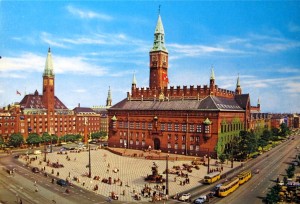
The Radhuspladsen (City Hall Square), which the boy and his father visit during the early part of the novel.
His father’s penchant for violence throughout this section is something the boy takes for granted, perhaps related to his father’s inherent need to prove that he and only he knows the world as it really is. As the resilient boy stays close to his unstable father, the boy’s intelligence, his loving attitudes, his willingness to trust people who seem to like him, and his increasing development of his artistic talent endear him to the reader who constantly hopes for his success. No matter how many promises his father makes and breaks, the boy always believes, and he never resents or even questions his father for disappointing him. A trip to Christiansborg, the seat of the Danish Parliament in 1989, foreshadows a dramatic event which changes their lives.
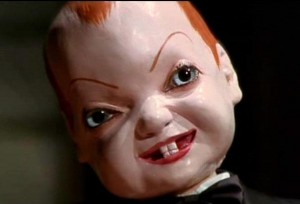
When the boy is a teenager, he and his girlfriend haunt the cinema and see Profondo Rosso, a film by Dario Argento
At the novel’s halfway point, the time frame shifts from 1986 – 1989 to 1996. The boy, now sixteen, is living in the suburbs. Later, another move takes him to a Danish island, where he learns much about his own background and that of his father, while also developing his art talent even more fully. By 1999, at the age of nineteen, he has a full-time job back in the city. How he gets there provides the reader with many vibrant scenes.
Filled with surprises, the action is non-stop, with the author pacing his dramatic moments so effectively that there are no “dead spots” in the novel. Past and present overlap, often converging unexpectedly and then veering in new directions to provide new information. The constant sense of menace contrasts with the intrinsic “niceness” of the boy and allows the reader to wish fervently for his ultimate success while always fearing the worst.
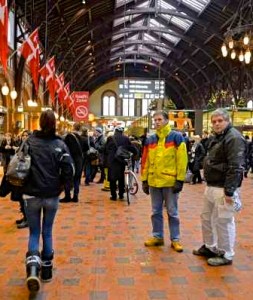
Hovedbanegarden, the central train station, from which the boy travels to and from the island and elsewhere.
The author controls his tone and the sense of atmosphere so well that it may not be until the conclusion that readers will actually begin to question the book’s depiction of “reality” and whether it actually makes sense. Unfortunately, a not-so-subtle misogyny also pervades the novel. From the story of the White Queen to the bad decisions the father makes, women are held accountable, yet the father’s biggest problems have not been caused by women. As the boy, in the third generation, tries to make sense of his adult world, the reader is left to wonder how successful he will be in avoiding the snares of the White Queen, while still hoping for his success.
Photos, in order: The author’s photo appears on https://www.babelio.com/
The memorial to Olov Palme at the site of his assassination in Sweden in 1986, is from http://www.thelocal.se
The Radhuspladen in Copenhagen was visited by the boy and his father early in the novel: http://travelerguidance.blogspot.com
The boy and his girlfriend go to the cinema to see the avant-garde film Profondo Rosso by Dario Argento: http://www.youmovies.it/2011/07/08/in-dvd-profondo-rosso-di-dario-argento
The central train station, the Hovedbanegarden, from which virtually all the boy’s trips are made, is shown here: http://ekstrabladet.dk/
ARC: Other Press

